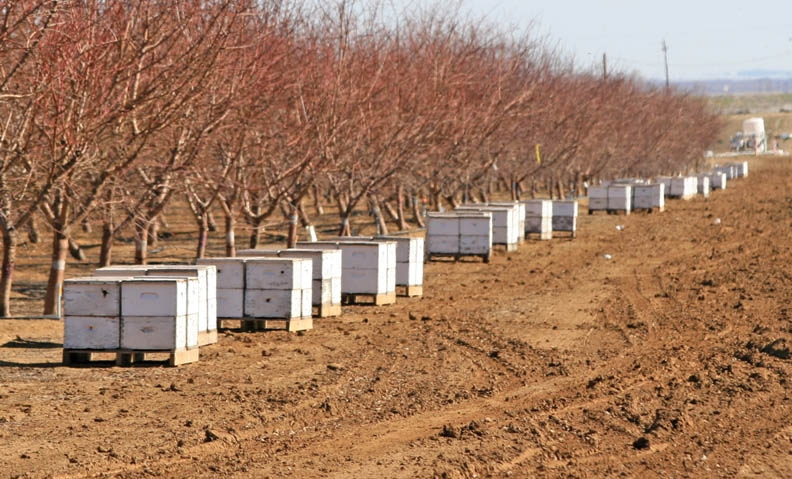July 7, 2011

Pollination is one of the biggest challenges facing California almond growers. The Almond Board of California continues to support research on honey bee health and self-compatible varieties to help growers contend with this challenge.
Even with the development of commercially viable self-fertile almond varieties, the need for honey bees to pollinate the state’s 750,000 acres of bearing almonds means that almond growers and beekeepers will have an ongoing, symbiotic relationship for a long time into the future.
Each year, some 1.5 million honey bee colonies are staged throughout California in preparation for pollinating the state’s almond orchards. Over the years, shifting crop patterns, economics, and other factors have challenged beekeepers’ ability to provide a healthy year-round foraging diet for these managed honey bees.
Disappearing food sources
At one time, more-diverse crop patterns as well as more-plentiful natural wildflowers and weeds provided year-round forage opportunities for beekeepers. This diverse forage promoted a healthy, polyfloral diet for honey bees that led to strong hives and improved pollination. Today, however, those crop patterns are shifting while at the same time, more acreage of bearing almonds has created a growing demand for healthy hives to pollinate the annual almond crop.
In the summer months, beekeepers typically move their colonies to open spaces out of state. One summer forage source has been prairie land in the upper Midwest. However, rising prices for grain crops are causing Midwest growers to put fallow land once in the Conservation Reserve Program back into summer grain production. Another challenge to summer forage sources is the shift in California citrus acreage. As California citrus growers transition their orange orchards to seedless citrus such as mandarins, they are working to prevent bees from pollinating to maintain seedless citrus crops, limiting beekeepers’ access to citrus as a summer pollen source. In addition, the move to Roundup Ready alfalfa and restrictions on alfalfa bloom in that GMO crop, are limiting access to alfalfa fields as a summer forage pollination source.
Commercial bee colonies begin arriving in California almond production regions in October and are moved into orchards to begin pollination in February.
There is a shrinking supply of good food sources for these colonies overwintering in California. Loss of nectar sources and urbanization have combined with other factors to seriously affect available food sources for pollinators in the winter.
Providing a crop or native plants that bloom before and after almonds would help improve honey bee health and could even reduce the cost of pollination services.
Costly supplements
With the shift in cropping patterns, beekeepers are often traveling farther to provide a year-round, polyfloral diet for their hives. In most cases they are also supplementing the bees’ natural diet with nutrient patties or pollen syrup during the winter. The result is added costs that are being passed along to growers.
Project Apis m. is searching for solutions to this and other challenges related to bee health and diet. Project Apis m. (PAm) is a collaborative effort of beekeepers and orchardists established five years ago to fund and direct research to improve the health and vitality of managed honey bee colonies while improving crop production.
Working through a USDA Specialty Crops Grant awarded to the California State Beekeepers Association, PAm hopes to encourage landowners and land managers to produce food resources for honey bees pollinating California specialty crops.
Participating in this research may be one way that almond growers can seize some control when it comes to improving pollination and helping stabilize the price for pollination services.
Planting bee pastures
The research project seeks to initiate two-to-three–year forage demonstration plots on seeded fields near commercial almond orchards. Crops such as rapini mustard would be planted in September and bloom sometime around November. This crop would provide a food source for bees, allowing beekeepers to bring bees near orchards at a time when they are challenged to find adequate pastureland and forage for their hives.
Most almond growers are in the business of raising permanent crops. They often do not have the equipment or resources to produce annual crops on their property. However, the project aims to demonstrate how the practice can work for growers. Trials will look at seed mixtures and management practices for fall and spring pollinator crops to increase bee pasture in California while demonstrating possible economical and/or ecological benefits to land owners and managers.
In theory, this strategy could provide almond growers with leverage in negotiating the price they pay for hives to pollinate their crop. It is possible that beekeepers would be willing to compensate growers who helped provide additional bee forage by reducing the cost of their pollination services. It also would promote healthier hives by diversifying the diet of those honey bees, creating stronger bees, and thereby improving the pollination within the orchards.
These are the variables that Project Apis m. seeks to explore. The group is anxious to work with almond growers to explore various forage possibilities in different almond growing regions of California. Growers interested in participating in controlled trials can contact Meg Ribotto at PAm, [email protected]. For more on almond pollination, go to AlmondBoard.com/Farmpress19.
You May Also Like




